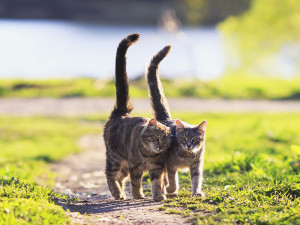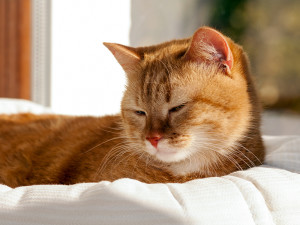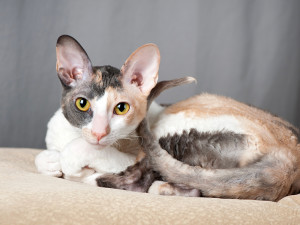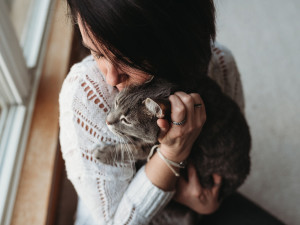Is Your Cat Mad at You, Or Is That Just Their Face?
Cat behaviorist Kristiina Wilson on how to tell if your cat is grumpy — or just kind of like that.

share article
Let’s face it: cats can be kind of (really) grumpy. In their defense, they’re usually annoyed for totally valid reasons — loud sounds, unwanted physical contactopens in a new tab, dirty bathroomsopens in a new tab, etc. — that’d ruin any human’s mood, too. But sometimes they just kind of look like that. And unless you’re Sabrina the Teenage Witch, your cat probably isn’t speaking English to let you know what they’re thinking. That’s why it’s important for pet parents to learn how to interpret their animal’s body language to understand what they’re trying to tell us. The Wildest talked to cat behaviorist Kristiina Wilsonopens in a new tab to find out how we can spot a frustrated feline.
Their Tail
One of the most important clues about a cat’s mood is their tailopens in a new tab. “A really happy cat who’s excited and happy to see you will have a tail up with a little bend in the tail,” Wilson says. “A cat who’s upset or fearful will have their tail down or tucked underneath their legs.”
You also want to keep an eye on the movement of a cat’s tail. “Every cat is different,” Wilson reminds us. “But for the most part, cats will use rapid movement at the tail — especially the tail tip — to indicate aggravation or irritation. A slow wave of the tail is usually happiness.” A thumping tail can mean that a cat is annoyed.
Wilson notes that tail positions and their meanings mean pretty much the same thing in both dogs and cats. So, checking a cat’s tail is a good jumping-off point for people who are more used to dog body language.
Their Ears
Similarly to tail position, ear position is pretty standard when it comes to both dogs and cats. “Ears that are pointed up are positive,” Wilson says. “Ears that go back are angry, and when they’re down and back they’re fearful.”
Piloerection (Hair Standing on End)
Piloerection is when a cat’s hair stands straight up — you’ve probably seen this depicted in Halloween illustrations of jumping black catsopens in a new tab. “When a cat does that, they are always, always either surprised or upset in some way,” Wilson explains. “They’re trying to make themself bigger. If you see a cat doing that, be careful around that cat, or see what’s going on that’s upsetting them.”
Arched Back
Like piloerection, an arched back is a recognizable Halloween posture. “The classic Halloween cat is a fearful cat, unfortunately,” Wilson says. “It’s a freaked-out cat.” A cat with an arched back is trying to appear larger, which is a sign that they might feel threatened.
Purring
Some people find it shocking, but the truth is that a purring cat isn’t always a happy one. Purring is often an indication of relaxation, but “purring can also be used to self-soothe when a cat is in pain or when they’re very unhappy,” Wilson says. “You really want to monitor if something else is going on that’s the reason they’re purring. You could have a cat who’s in physical distress.”
It’s important to remember that no one piece of body language can draw a concrete conclusion about your cat’s state of mind. “You want to look at all these things in conjunction,” Wilson says. “If you have a cat who’s otherwise seemingly happy but the pupils are dilated, it could just be that the cat is about to play or is playing and is about to pounce on something. You don’t want to take any one of these things and say, ‘Oh no, my cat is upset.’ You have to look at them holistically.”
And because cats are pros at hiding when they’re in painopens in a new tab, any behavioral change should be considered as a potential health concern, as well as an emotional one. If negative body language is accompanied by things like vocalization, low energy, or hiding, your cat should be taken to a vet to be sure they aren’t trying to grin and bear it through an injury or illness.
If you want to help chill out a grumpy cat, Wilson recommends slow blinkingopens in a new tab. It’s proven to calm catsopens in a new tab and strengthen human-cat bonds, and you get a selfless excuse to stare at your pet. You can tell them, “It’s not creepy. It’s for your health.”

Sio Hornbuckle
Sio Hornbuckle is a writer living in New York City with their cat, Toni Collette.
Related articles
![]() opens in a new tab
opens in a new tabHow to Read Your Cat’s Poker Face
A guide to their not-so-secret tells.
![White and light brown cat laying down with eyes almost closed]() opens in a new tab
opens in a new tabStudy Says “Slow Blinking” at Your Cat Helps You Bond
A team of psychologists at the Universities of Sussex and Portsmouth have discovered the key to building a bond with cats.
![Cornish Rex cat laying down on a pillow]() opens in a new tab
opens in a new tabThe Cat Breed-Behavior Connection
Which cats are more likely to have stranger danger? Bite the hand that feeds them? Do the zoomies? Scientists studied 5,700 pet cats and discovered some interesting traits.
![Woman in a white sweater hugging her cat next to a window]() opens in a new tab
opens in a new tabIs Your Cat SAD?
Four ways cats can combat seasonal depression.






